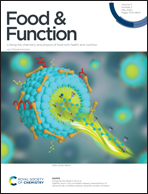Lipophilic ferulic acid derivatives protect PC12 cells against oxidative damage via modulating β-amyloid aggregation and activating Nrf2 enzymes†
Abstract
Ferulic acid (FA) has been shown to have a neuroprotective effect on Alzheimer's disease induced by amyloid-beta (Aβ) neurotoxicity. This work aims to ascertain the structure–activity relationship of FA and its alkyl esters (FAEs) for evaluating the antioxidant activities in PC12 cells and Aβ1–42 aggregation inhibitory activities in vitro, as well as the signaling mechanisms against oxidative stress elicited by Aβ1–42 in PC12 cells. Our data showed that alterations in the subcellular localization and cytotoxicity of FAEs caused by the lipophilicity of FA were crucial when evaluating their antioxidant capacities. Pre-treating cells with butyl ferulate (FAC4) significantly attenuated Aβ1–42-evoked intracellular ROS formation. Besides, FAC4 exhibited the highest Aβ1–42 aggregation inhibitory effectiveness. The molecular docking results showed that FAC4 binds to amide NH in Gln15 and Lys16 via a hydrogen bond. Notably, FAC4 could upregulate antioxidant defense systems by modulating the Keap1-Nrf2-ARE signaling pathway. Identification of the functions of FAEs could be useful in developing food supplements or drugs for treating AD.



 Please wait while we load your content...
Please wait while we load your content...